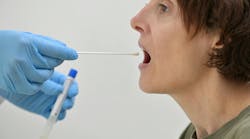In 2007, MLO presented a series of
commentaries, “Tradition in transition,” addressing three major issues
involved in the laboratory personnel shortage: education, work ethic,
and technology. At the time, drastic measures seemed imperative if
employers were to keep qualified medical laboratorians in sufficient
numbers to staff the nation's clinical laboratories with the coming
“tsunami” of some 74 million health-conscious aging baby-boomer
patients.1
While MLTs and MTs were retiring at a clip of 10,000
to 12,000 a year for nine years, the recent reversals in economic
fortunes may have set the stage for many baby-boomer lab pros to either
stay longer in or return to the lab. According to
statistics, “those between 55 and 64 have lost 38% of their net worth
[with] few years left to make up the losses; 30% of those
aged 45 to 54 are “under water” in their homes and have lost 45% of
their median net worth.1 Will the 2009 recession spare the
lab for a few years while boomers rebuild their fortunes?
Replenishing the nation's laboratory brain trust
Much attention directed toward the closing of
Clinical Laboratory Science (CLS) programs gave rise to rumors that the
study of medical laboratory science as we have known it was dying a slow
death. Concurrently, two CLS programs were actively contrasting
“tradition” vs. “transition;” whatever the reasons for the end of one
and the birth of another, the example echoes CLS education seeking new
life in a different guise. As the University of Wisconsin-Madison
announced earlier this year that it would close its traditional CLS
program upon the graduation of the current 80 junior and senior
students, a news brief came across the wire that the University of
Arizona (UA) had instituted a CLS program that combines and/or draws
support from several entities.
UA's Department of Biochemistry and Molecular
Biophysics, along with its Department of Pathology of the College of
Medicine, and the University Medical Center will operate the UA CLS
program in the Arizona Health Sciences Center. This program integrates
an undergraduate biochemistry degree with CLS distance-learning at the
University of North Dakota-Grand Forks (ND-GF). UA students can take
ND-GF CLS courses online as electives and receive training in Tucson's
University Medical Center clinical labs. With its departmental
“molecular edge,” UA linked with related local entities and ND-GF to
provide a creative new CLS program configuration.
Automating almost everything laboratory
Of our trilogy, technology seems to have succeeded
above all else: The explosion of automated equipment that industry has
introduced in the past quarter century allows fewer lab techs to
maintain workloads that are increasing yearly and will peak when those
74 million boomers suffer the plethora of senior ailments and illnesses
that require laboratory attention. Manual labor required today in the
lab compared with that of 10 years ago makes it evident that innovation
has taken center stage. Obvious evidence are labor-saving medical
devices such as vein finders or various point-of-care instruments, for
starters. Various combinations of automated equipment for handling blood
banking, hematology, and chemistry make it possible for fewer lab techs
to do more testing with less effort. The use of computers via the
Internet make collaboration/consulting between/among hospital
labs/pathology groups an efficient way of accomplishing many different
laboratory goals. Strategies suggested in IVD Technology's “The
future of automation in clinical laboratories” by Zakowski and Powell
are widely accepted solutions to the medical lab's major problems: Run
more tests, test in fewer sites, operate with fewer instruments, retain
lower operating costs, employ relatively less-skilled labor, and use
more automation in a paperless environment.2
The work ethic debate
The supposed lack of a younger generation's work
ethic has engaged older lab workers. Is it really surprising today that
there is chafing between/among these groups in all workplaces?
“Parents,” says Haim Ginott, “often talk about the younger generation as
if they didn't have anything to do with it.”
In 1999, the National Accrediting Agency for Clinical
Laboratory Sciences issued its “Program Revitalization Strategies for
Survival”3 which contained many well thought-out ideas for
recruiting students into the field. For the past several years, Labs Are
Vital (www.labsarevital.com), initiated by Abbott and
supported by many in the industry, has worked diligently at inviting
young folks into the field. In ASCP's 2009 “Wage and Vacancy Survey of
U.S. Medical Laboratories,”4 figures demonstrate the
determination to improve the profession in terms of salary levels and
distribution of employee shortages nationally. As much “chafing” as may
go on, aging laboratory scientists eventually are going to be
replaced. Marcus Tullius Cicero, a Roman lawyer, writer, scholar,
orator, and statesman (106 BC-43 BC), once asked, “What nobler
employment, or more valuable to the state, than that of the man who
instructs the rising generation?”
References
- Center for Economic and Policy Research. The
Wealth of the Baby Boom Cohorts After the Collapse of the Housing
Bubble.
http://www.cepr.net/index.php/publications/reports/the-wealth-of-the-baby-boom-cohorts-after-the-collapse-of-the-housing-bubble .
Accessed October 26, 2009. - Powell D, Zakowski J. IVD Technology: The
future of automation in clinical laboratories.
http://www.devicelink.com/ivdt/archive/99/07/010.html . Accessed
October 26, 2009. - National Accrediting Agency for Clinical
Laboratory Sciences. Program Revitalization Strategies for Survival,
February 1999.
http://www.naacls.org/docs/Program_Revitalization_Manual.doc .
Accessed October 26, 2009. - Bennett A, Holladay B, Steward C. Lab Medicine.
2009;40(3):133-141.





